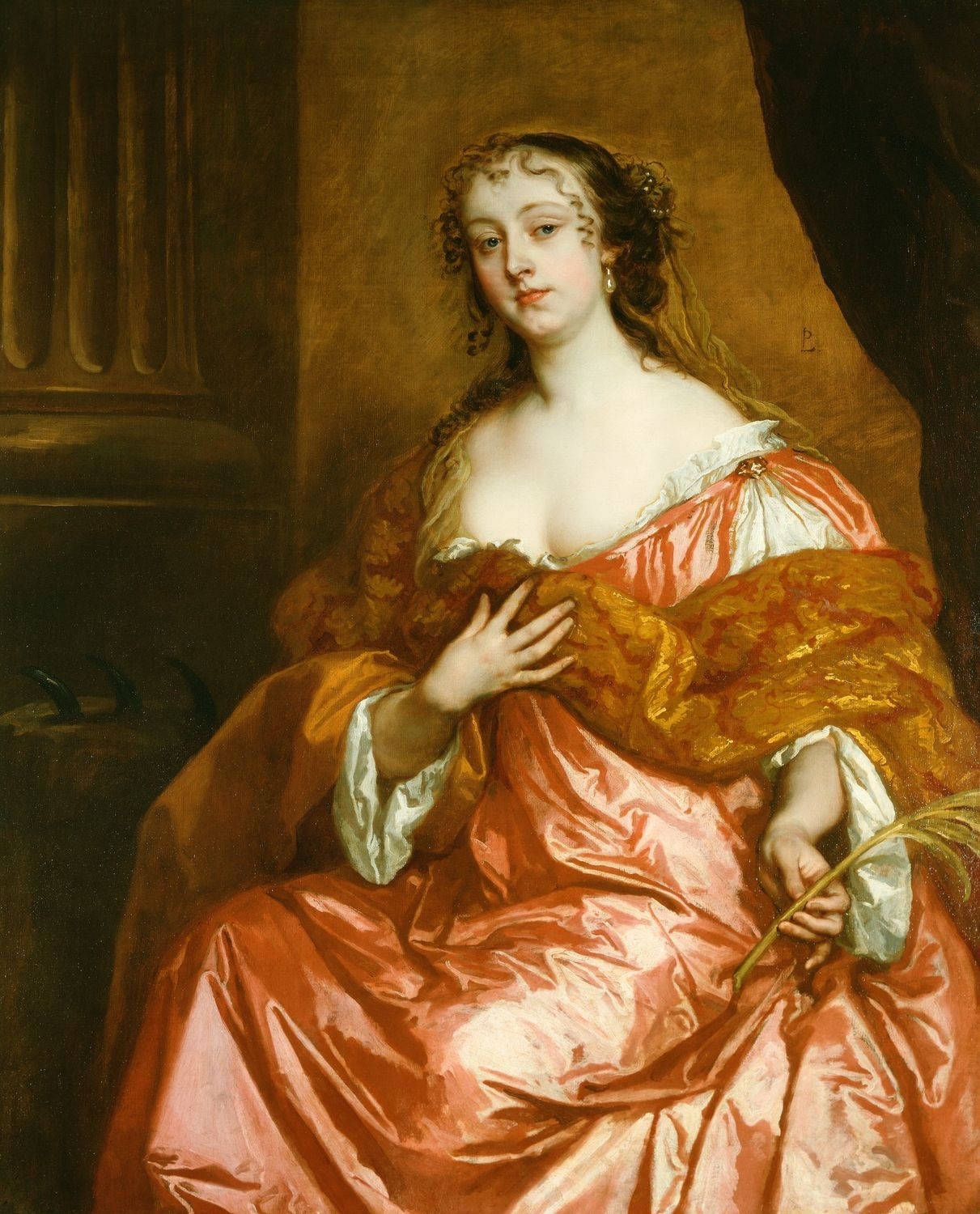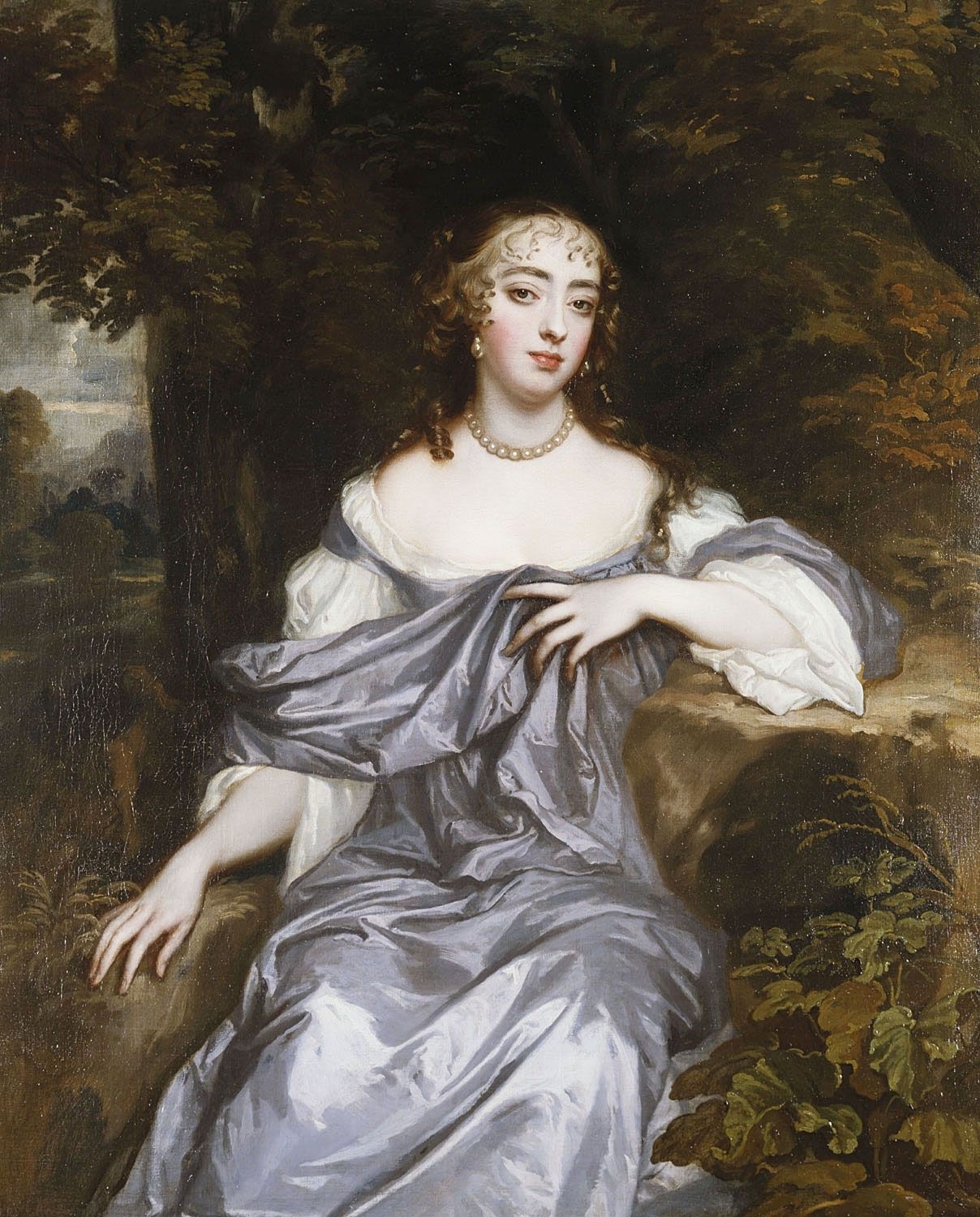
she caught the eye of Charles II, who fell in love with her. The king's infatuation was so great that when the queen's life was despaired of in 1663, it was reported that he intended to marry Stewart, and four years later he was considering the possibility of obtaining a divorce to enable him to make her his wife because she had refused to become his mistress.
Following the war with the Dutch, Charles had a commemorative medal cast, in which her face was used as a model for Britannia; this subsequently became customary for medals, coins and statues. She continued to appear on some of the copper coinage of the United Kingdom until the decimalization of the currency in 1971.[2] She also appeared on the fifty pence piece in 2006. More on Frances Teresa Stewart
Lely flattered his subjects, and gave each portrait a similar languorous and ‘sleepy eyed’ air, said to have been influenced by the features of the noted court beauty Barbara Villiers, Duchess of Cleveland who was painted many times by Lely. Only one of the sitters, Frances Teresa Stuart actually held the position of Maid of Honour in the Royal Household. Some of the others were noted courtesans, while others were respected members of the nobility.

She was married in London to Philibert, Count de Gramont, a French exile at the English court. "La belle Hamilton" was one of the great beauties of the English court. When Gramont was given permission to return to France, however, he left in a haste.
She followed her spouse to France in 1669, where she was made Dame du Palais to the French queen. She was a woman of considerable wit, and held her own at the court of Louis XIV, but her husband pursued his gallant exploits to the close of a long life. In 1696, her spouse was afflicted with a grave illness, and after he recovered, he turned to a religious life, in which she followed him. She died one year after being widowed. More on La Belle Hamilton
In 1674, after the death of Anne Hyde, the pictures were hanging as a group in the White Room at Whitehall. Eleven pictures are mentioned in the inventory, although only ten are identified today as belonging to the group. The series was taken from Whitehall to Windsor. During the reign of Queen Anne they were hung in the Queen’s Waiting Room and later in the Queen’s State Bedchamber. They were at Hampton Court by June 1835. More on Communication Gallery, Hampton Court Palace

Jane was married at Lambeth Church on 18 June 1660 to Charles Myddelton of Ruabon, third surviving son of Sir Thomas Myddelton of Chirk. Myddelton and his wife lived in London and appear to have subsisted for a time upon the bounty of relatives. A legacy from Lady Needham fell in upon that lady's death in 1666, and another upon Sir Thomas Myddelton's death in the same year.
After the accession of James II, "Mrs. Myddelton" enjoyed an annual pension of £500 from secret service money. Her husband, who had for some years held a place of about £400 a year in the prize office, died insolvent in 1691. She died in the following year, and was buried beside her husband in Lambeth Church.
As a married woman was much courted by men; she is now thought to have taken just two lovers, Ralph Montagu and Laurence Hyde, 1st Earl of Rochester. Antonia Fraser writes that her life "was founded on masculine support in return for sexual favours", but also that her affairs "were seen more as a tribute paid to her great beauty". She was an amateur artist capable of contributing to the iconography of her portraits. Besides that by Peter Lely in the "Windsor Beauties" series, there was second Lely portrait (1666) commissioned by Robert Spencer, 2nd Earl of Sunderland for another series. More on Jane Needham


Her father was Sir William Brooke (1601–1643), and her mother was Penelope Hill ( -c.1694). Frances was first married to Sir Thomas Whitmore ( -1682), had three children with him. She then married Matthew Harvey ( -c.1693/94). She lead a life of quiet domesticity away from the hurly burly of court life. More on Frances Brooke

Her father was Col. Henry Bagot, and mother was Dorothea Arden. She married Charles Berkeley, 1st Earl of Falmouth in 1663. He died at the Battle of Lowestoft. The widowed Countess of Falmouth, lady-of-the-bedchamber to the Queen appears in the various lists of the King’s mistresses, though apparently not as one of the main contenders. She then married Charles Sackville, 6th Earl of Dorset in June 1674. This second marriage for Mary Bagot terminated after five years with her death in childbirth. More on Mary Bagot

Like most of the Boyle dynasty, who in the space of two generations had become almost all-powerful in the south of Ireland, Henrietta was strong-minded and acquisitive, and could be ruthless in asserting her rights. During the last two years of her life, when her husband was Chief Minister to his brother-in-law King James II, Henrietta took full advantage of his power to claim every possible privilege. She clashed bitterly with her husband's niece, the future Queen Anne over who should have the best apartments in Whitehall Palace. She died 1687 in her 42nd year. More on Henrietta Hyde

Barbara was the subject of many portraits, in particular by court painter Sir Peter Lely. Her extravagance, foul temper and promiscuity provoked diarist John Evelyn into describing her as the "curse of the nation", whereas Samuel Pepys often noted seeing her, admiringly.
Barbara's 1st cousin Elizabeth Villiers (later 1st Countess of Orkney 1657–1733) was the only acknowledged mistress of King William III. More on Barbara Villiers

Sunderland had previously broken off their long-standing engagement. He told his friends that he had reason enough and was resolved never to have her. He soon had second thoughts and their mothers worked together to produce a reconciliation which resulted in an entirely successful marriage. She was a lady-in-waiting to Mary of Modena during the reign of James II, and was present at the birth of the Prince of Wales, signalling to the king that his new child was a boy.
She is alleged to have had an affair with Henry Sidney, Earl of Romney, her husband's uncle. Her devotion to her husband was never seriously questioned; his biographer considered that it was principally his happy marriage which sustained Sunderland through a long and unhappy life.
She had at least five children by Sunderland, only one of whom outlived her. More on Anne Digby

She married Joceline Percy, 11th Earl of Northumberland, on 23 December 1662. They had two children. She traveled with her husband to Italy, where he was taken ill and died in Turin, the next year. Upon his death, being a wealthy heiress, she married Ralph Montagu, 1st Duke of Montagu, at Titchfield, Hampshire, on 24 August 1673. More on Elizabeth Wriothesley

He arrived in London in around 1641. His early English paintings, mainly mythological or religious scenes, or portraits set in a pastoral landscape. Lely's portraits were well received, and became the most fashionable portrait artist in England. He became a freeman of the Painter-Stainers' Company in 1647 and was portrait artist to Charles I. His talent ensured that his career was not interrupted by Charles's execution, and he served Oliver Cromwell, whom he painted "warts and all", and Richard Cromwell.
After the English Restoration in 1660, Lely was appointed as Charles II's Principal Painter in Ordinary in 1661. Lely became a naturalised English subject in 1662.
Among his most famous paintings are a series of 10 portraits of ladies from the Royal court, known as the "Windsor Beauties", formerly at Windsor Castle but now at Hampton Court Palace; a similar series for Althorp; a series of 12 of the admirals and captains who fought in the Second Anglo-Dutch War, known as the "Flagmen of Lowestoft", now mostly owned by the National Maritime Museum in Greenwich; and his Susannah and the Elders at Burghley House.
His most famous non-portrait work is probably Nymphs by a fountain in Dulwich Picture Gallery.
Lely was knighted in 1680. He died soon afterwards at his easel in Covent Garden, while painting a portrait of the Duchess of Somerset, and was buried at St Paul's Church, Covent Garden. More on Sir Peter Lely
Please visit my other blogs: Art Collector, Mythology, Marine Art, Portrait of a Lady, The Orientalist, Art of the Nude and The Canals of Venice, Middle East Artists, 365 Saints and 365 Days, also visit my Boards on Pinterest
Images are copyright of their respective owners, assignees or others.
Some Images may be subject to copyright
I don't own any of these images - credit is always given when due unless
it is unknown to me. if I post your images without your permission, please tell
me.
I do not sell art, art prints, framed posters or reproductions. Ads are
shown only to compensate the hosting expenses.
If you enjoyed this post, please share with friends and family.
Thank you for visiting my blog and also for liking its posts and pages.
Please note that the content of this post primarily consists of articles
available from Wikipedia or other free sources online.



No comments:
Post a Comment